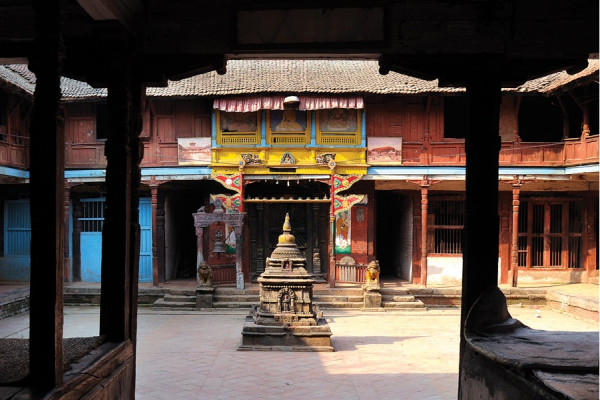A Closer Insight to a Newari House

There are contemporary Newar houses that have adapted traditional methods and modern designs, without compromising their heritage value.
Untouched by the temptations of the Western culture, the lifestyle of the Newars, the oldest inhabitants of Kathmandu Valley, has remained relatively similar over the years. The cultural and religious convictions the Newari community abides by, can be substantiated by their outlook on architecture. Even today, the medieval aura is upheld by the Pati-Pauwas’, tiered pagoda style temples, chowks and bahals and rectangular houses with tiled roofs seen in the major cities of the valley.
The Newari settlement, formed of dense population, share similar lifestyles and building methods. The Newari houses are narrow, rectangular shaped, made of exposed brick with finely detailed wooden carvings and tiled roof which ooze history and antiquity. Resided by a dense population, these houses are built following the perimeter of a courtyard, known as ‘Chowk’. Everyone living in and around the similar chowk, take it as their gathering point for all social activities or just casual meetings. The cluster of these houses is apparently possible for the uniformity in their design.
These days with the changing lifestyles, there is a change in spatial usage in the houses, but the fundamental space usage custom is the same. A spine wall, ‘Du Angha’ divides the front of the house to the ground floor room called ‘Chiddi’ into two spaces. The façade would most probably have a shop or a workshop whereas, the latter space would have a store room or a stable alongside the staircase in the corner. The other floors were used for living and the attic was used as kitchen and dining area or storerooms.
The best kept secrets lie in the attic of Newari houses traditionally called ‘Baigah’ or ‘Buigal’. A small wooden staircase leads to the trap door, two heavy planks locked by chains, that closes off the stairway to the attic. Some use the attic as kitchen, while some as storerooms or place of worship where no one except the head of the family is allowed. The houses in the medieval era were built attached to one another, identical to each other to host feasts. Each attic attached to one another and were connected by doors. The doors are kept open at the same time to form a long passage to hold a communal feast. However, this design has seen changes due to the growing number of party and feast venues.
Fusion is evitable in every array of things that people come in contact with. The Newari houses are no exception to this. These days, houses are built with the innovative fusion of modern and traditional construction methods, i.e. a structural frame with concrete column and beams, encircled with thick walls, made with mud mortar. The mud mortar construction keeps the house relatively cooler in summer and warmer in winter. There are contemporary Newar houses that have adapted traditional methods and modern designs, without compromising their heritage value.
Comparatively, the older buildings have smaller squared windows with lintels. The size of the windows may vary depending upon the use of the rooms. A prominent feature of the older buildings is the ‘San Jhya’ a richly decorated window that covers the façade, with seating framed within it. In recent construction, the concept of ‘San Jhya’ has been extended to each floor, so that there are less brick walls on the facade of the houses, making the house appear more attractive.
The functional planning of the Newar houses is a mix of residential and commercial purposes. Traditionally, these were single family houses with shops or workshops on the ground floor, but with the saturation of building plots and expensive costs, the houses host more than one family today. The major modifications in the Newari house consists of updated hygienic facilities such as running water and toilets, replacement of traditional timber floor with concrete slabs, mud façade with cemented facade.
The devastating Nepal earthquake in 2015 caused huge loss of lives and properties. Several traditional buildings and monuments, world renowned for indigenous Newari architecture in Kathmandu Valley literally collapsed to the ground. Owing to the loyalty and devotion the Newars hold for their culture, the rich Newari architecture and monuments are on the verge of rebirth; taller and stronger than before, which can stand strong for generations.
